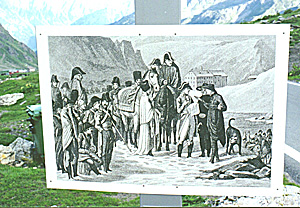 The traveller's base for preparing to pass over the Alps, and the First Consul's headquarters from the 17th to the 20th of May, 1800, is the Swiss town of Martigny, in the French-speaking canton of Valais.
The traveller's base for preparing to pass over the Alps, and the First Consul's headquarters from the 17th to the 20th of May, 1800, is the Swiss town of Martigny, in the French-speaking canton of Valais.
Already a bustling center of transalpine trade in Roman times, Martigny offers some fine Roman remains including a small but nearly-intact amphitheatre. Bonaparte, with his well-known fondness for the ancient Romans, probably enjoyed the amphitheatre, and so should you.
The modern visitor with any time to spare should also explore the collections of the Fondation Pierre Gianadda, a classy cultural center which blends Gallo-Roman archaeology, a museum of vintage automobiles, a modern sculpture garden, and major art exhibitions (see http://www.gianadda.ch for details).
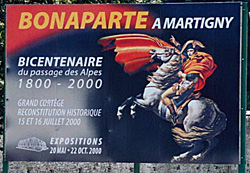 In Martigny in July 1999, a billboard by the amphitheatre announced an historical reenactment of the passage of the Alps, scheduled for 15-16 July 2000. It should be a cause for amusement and a mark of honor for Bonaparte's army that their modern successors, with a paved road and the logistic support of motor vehicles, prefer to wait for the kinder weather of summer rather than force their way through the snow on the actual bicentennial of Napoleon's Passage of the Alps.
In Martigny in July 1999, a billboard by the amphitheatre announced an historical reenactment of the passage of the Alps, scheduled for 15-16 July 2000. It should be a cause for amusement and a mark of honor for Bonaparte's army that their modern successors, with a paved road and the logistic support of motor vehicles, prefer to wait for the kinder weather of summer rather than force their way through the snow on the actual bicentennial of Napoleon's Passage of the Alps.
The road to the Great St. Bernard is clearly signposted. At the fork about 4 km past Bourg-St.-Pierre, the last village in Switzerland, make sure you take the route to the "col" (pass) and not the tunnel.
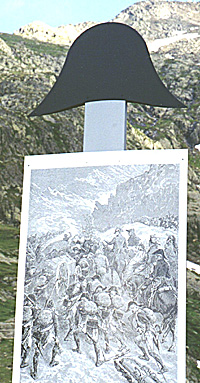 Pulling a trailer over the pass is not recommended, but the two-lane pavement is well-maintained and the grades are easily handled by an ordinary passenger car in low gear.
Pulling a trailer over the pass is not recommended, but the two-lane pavement is well-maintained and the grades are easily handled by an ordinary passenger car in low gear.
Nearing the summit: "Allez-y, les gars!"
Once above the treeline, the terrain quickly becomes wild and lonely and the temperature drops. There were considerable patches of snow persisting when we visited in July 1999. Warm clothing is essential!
In commemoration of the bicentennial of the march of the Army of Reserve, the local communities took the delightful initiative of erecting weatherproof metal signbords (each topped by a black Napoleonic hat) featuring black-and-white reproductions of Nineteenth-Century paintings depicting the French passage of the Alps.
Each reproduction is placed along the road more-or-less at the location it portrays, and where there is room to pull a car off the pavement.
These paintings are a wonderful stimulus to the imagination. Who could stand in such a spot and not hear the echoes of French shouts of command, the tramp of men and beasts in the snow punctuated by the occasional slither and fall, and a rolling chorus of curses and groans?
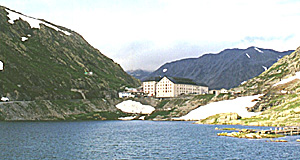 Pause a while, and chances are you will also see (and smell!) the ghosts of the blue-coated thousands.
Pause a while, and chances are you will also see (and smell!) the ghosts of the blue-coated thousands.
The monastery and lake in July 1999.
At the summit of the pass, the buildings of the monastery still stand, little changed from their depiction in the old paintings.
The interior of the monastery, with the tomb of General Desaix and a museum illustrating the history of the Great St. Bernard Pass, is said to be well worth a visit.
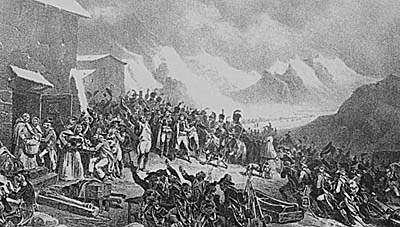 Unfortunately, we had lingered too long in Martigny and the monastery was closed for the day by the time we arrived. The art-reproduction signboards cluster thickly around the summit, reflecting the excitement of artists, soldiers, and travellers with the physical and symbolic passages that took place here 16-21 May 1800:
Unfortunately, we had lingered too long in Martigny and the monastery was closed for the day by the time we arrived. The art-reproduction signboards cluster thickly around the summit, reflecting the excitement of artists, soldiers, and travellers with the physical and symbolic passages that took place here 16-21 May 1800:
Over the roof of Europe, through the gateway into Italy, with plenty of allusions to the meeting of the spiritual and the secular as the monks greet Bonaparte and feed the troops.
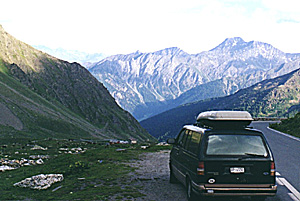 The artists imply that God favored France, but the monks would probably have been equally charitable to an Austrian army going the other way!
The artists imply that God favored France, but the monks would probably have been equally charitable to an Austrian army going the other way!
The drive down from the pass toward Aosta is even more visually rewarding than the climb, with vistas sweeping open before you and the countryside becoming richer as you descend like a conqueror toward the fabled plains of Italy.
However, this is no place for careless overconfidence and complacency. On the road ahead still looms the ominous Fort de Bard.
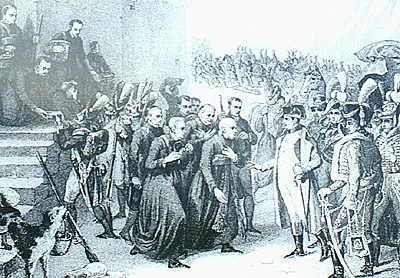
More Marengo
-
Marengo: Introduction
Marengo: Great St. Bernard Pass
Marengo: Fort Bard
Marengo: The Battlefield
Marengo: Jumbo Battlefield Maps (very slow: 256K)
Back to List of Battlefields
Back to Travel Master List
Back to MagWeb Master List of Magazines
© Copyright 2000 by Bill Peterson.
This article appears in MagWeb (Magazine Web) on the Internet World Wide Web.
Other military history articles and gaming articles are available at http://www.magweb.com